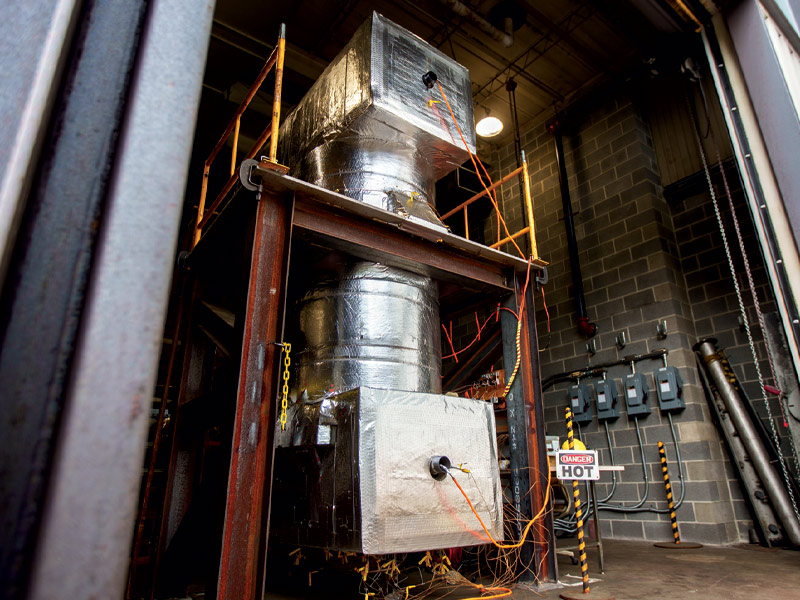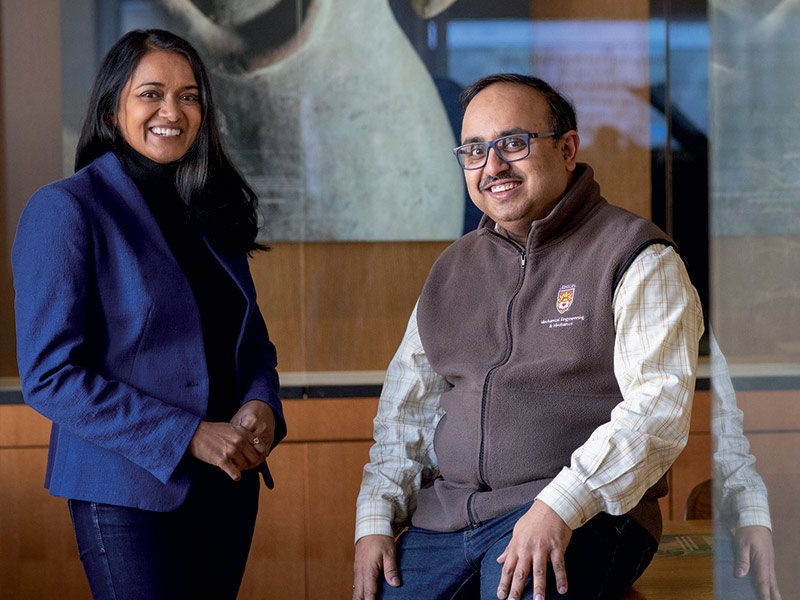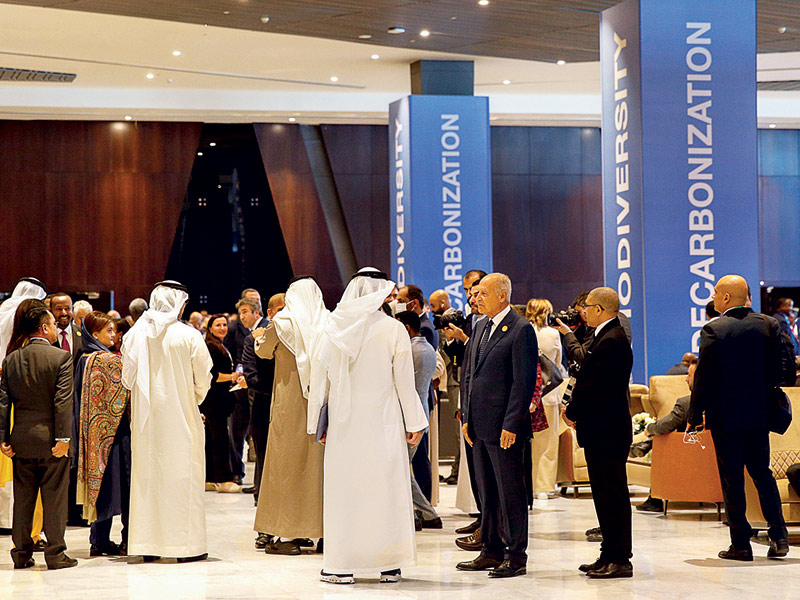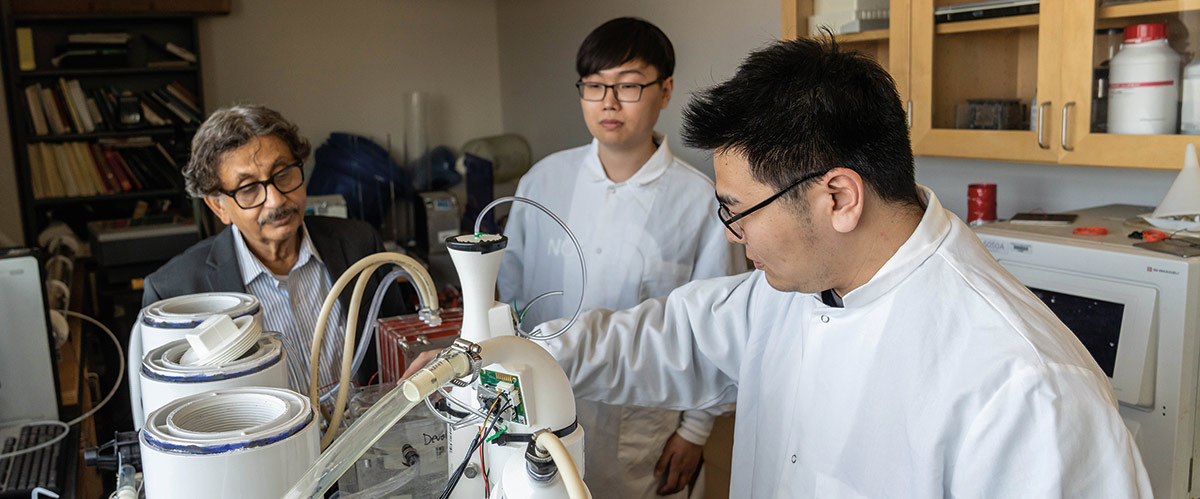
(Left to right) Arup SenGupta, Zhongyu Shi ’23G, and Xinkai Wu ’23G in SenGupta’s lab.
Lehigh Engineering researcher Arup SenGupta has developed a novel way to capture carbon dioxide from the air and store it in the “infinite sink” of the ocean.
The approach uses an innovative copper-containing polymeric filter and essentially converts CO2 into sodium bicarbonate (aka baking soda) that can be released harmlessly into the ocean. This new hybrid material, or filter, is called DeCarbonHIX (i.e., decarbonization through hybrid ion exchange material), and is described in a paper recently published in the journal Science Advances.
The research, which demonstrated a 300 percent increase in the amount of carbon captured compared with existing direct air capture methods, has garnered international attention from media outlets like the BBC, CNN, Fast Company, and The Daily Beast, and professional organizations like the American Chemical Society. SenGupta himself has been fielding interest in the technology from companies based in Brazil, Ireland, and the Middle East.
“The climate crisis is an international problem,” says SenGupta, who is a professor of chemical and biomolecular engineering and civil and environmental engineering in Lehigh’s P.C. Rossin College of Engineering and Applied Science. “And I believe we have a responsibility to build direct air capture technology in a way that it can be implemented by people and countries around the world. Anyone who can operate a cell phone should be able to operate this process. This is not technology for making money. It’s for saving the world.”
The work is yet another extension of SenGupta’s personal and professional commitment to developing technologies that benefit humanity, and in particular, marginalized communities around the world. His research on water science and technology has included drinking water treatment methodologies, desalination, municipal wastewater reuse, and resource recovery. He invented the first reusable, arsenic-selective hybrid anion exchanger nanomaterial (HAIX-Nano), and as a result, more than two million people around the world now drink arsenic-safe water. Two of his patents have been recognized as “Patents for Humanity” by the US patent and Trademark Office.
His invention of DeCarbonHIX was the outcome of an ongoing CO2-driven wastewater desalination project funded by the Bureau of Reclamation under the jurisdiction of the U.S. Department of the Interior. SenGupta and his students were on the lookout for a reliable supply of CO2 even in remote places. That quest led the way to the field of direct air capture, or DAC, and the creation of DeCarbonHIX. This subject was the dissertation topic for environmental engineering student Hao Chen ’23 PhD, who successfully defended his PhD in March and will receive his doctorate in May.
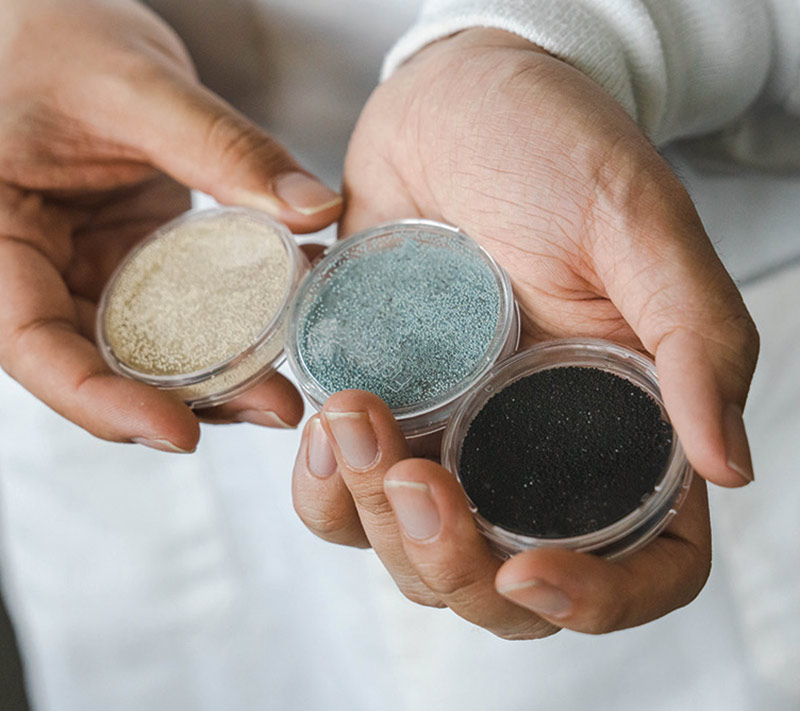 Capturing carbon at lower concentrations
Capturing carbon at lower concentrations
The most abundant of the greenhouse gasses contributing to global warming is carbon dioxide. In 2021, global emissions of CO2 rose by 6 percent from the previous year—to 36.3 gigatons, according to the International Energy Agency. Just one gigaton (equal to 1 billion tons) is the equivalent of the mass of all land mammals on earth.
Emissions from greenhouse gasses have increased global temperatures by approximately 1.1 degrees Celsius above pre-industrial levels, according to the Intergovernmental Panel on Climate Change. In its 2021 working group report, the IPCC estimates the average yearly temperature over the next 20 years is expected to rise by at least 1.5 degrees Celsius. The warmer the earth gets, the greater the fallout in terms of rising sea levels, extreme storm events, and ecological disruption, all of which have repercussions on global health, security, and stability.
“The worst part of this crisis is that people who are marginalized, who are poor, will suffer 10 times more than those who contributed to this situation,” says SenGupta.
There are three ways to reduce CO2, he says. The first—government action—can reduce emissions, but that won’t address what’s already in the air.
“The second way is removing it from point sources, places like chimneys and stacks where carbon dioxide is being emitted in huge amounts,” he says. “The good thing about that is you can remove it at very high concentrations, but it only targets emissions from specific sources.”
The newest method is called direct air capture, which, he says, “allows you to remove CO2 from anywhere, even your own backyard.”
With DAC, chemical processes remove CO2 from the atmosphere, after which it’s typically stored underground. However, says SenGupta, the technology is limited by its capacity. It can’t capture enough CO2 to overcome the energy cost of running the process.
“If you’re capturing carbon dioxide from a chimney at a plant, the amount of CO2 in the air can be upwards of 100,000 parts per million,” he says. “At that concentration, it’s easy to remove. But generally speaking, the CO2 level in the air is around 400 parts per million. That’s very high from a climate change point of view, but for removal purposes, we consider that ultra-dilute. Current filter materials just can’t collect enough of it.”
Another challenge with DAC involves storage. After the CO2 is captured, it’s dissolved, put under pressure, liquified, and typically stored miles underground. A DAC operation must then be located in an area with enough geological storage—and stability. A country like Japan, for instance, can’t pump CO2 underground because the area is prone to earthquakes.
Seeing a solution in seawater
SenGupta has developed a DAC method that overcomes both the capture problem and the issue of storage.
For the capture problem, he developed DeCarbonHIX—a mechanically strong, chemically stable sorbent (a material used to absorb liquids or gasses)—that contains copper.
“The copper changes an intrinsic property of the parent polymer material and enhances the capturing capacity by 300 percent,” he says. “We showed that for direct air capture from air with 400 parts per million of CO2, we achieve capacity, meaning capacity is no longer a function of how much carbon dioxide is in the air. The filter will get saturated completely at any concentration, which means you can perform DAC in your backyard, in the middle of the desert, or in the middle of the ocean.”
The ocean is actually SenGupta’s solution to the storage problem. His DAC process starts with air blowing through the filter to capture CO2. Once the filter is saturated with gas molecules (determined by measuring the amount of gas going into the filter versus coming out of it), seawater is passed through the filter. The seawater converts the carbon dioxide to sodium bicarbonate (you likely know it as baking soda, but lose the visual as we’re talking about a dissolved solution here). The dissolved sodium bicarbonate is then released directly into the ocean, what Sengupta calls “an infinite sink.”
“And it has no adverse impact on the ocean whatsoever,” says SenGupta. “It doesn’t change the salinity at all.”
In fact, he says, the sodium bicarbonate, which is slightly alkaline, may improve the health of the ocean. That’s because elevated levels of CO2 in the atmosphere have gradually reduced the pH of the ocean, causing acidification. More acidic waters harm the growth and reproduction of marine life like corals and plankton and can create catastrophic collapses in the food chain.
“Sodium bicarbonate may reverse that lowering of pH,” he says.
It’s worth noting, he says, that like existing DAC processes, DeCarbonHIX can also be desorbed with hot water or steam, and pure CO2 can be recovered, compressed, and stored underground in geological storage.
“In reality, this new filter material offers a dual mode of desorption and sequestration.”
Adding renewables into the mix
The third part of SenGupta’s innovative method involves conditioning the filter, essentially restoring it to the state in which it can begin capturing CO2 again. (Cleaning it, in other words.) The process requires passing a diluted solution of sodium hydroxide through the filter.
“Now the question is, where will this sodium hydroxide come from? In many places, it’s likely already a waste material, but sodium hydroxide can also be made using seawater, and the energy required to make it can come from renewable sources like solar and wind. If the goal is to remove CO2, you should be emitting as little CO2 in the process as possible. The goal is net zero direct air capture.”
SenGupta envisions an offshore platform of sorts that hosts the entire operation. As the air blows, the filter would capture carbon dioxide until it’s saturated, at which point seawater would convert the gas to a sodium bicarbonate solution, and sodium hydroxide created from seawater would restore the filter to operational status. Energy from waves, wind, and/or the sun would power it all. Such platforms would be spread far and wide in a universal attempt to capture 100 million tons of CO2 in five to seven years.
“Scale is important here,” he says. “And it’s a scale that we’ve never dealt with before in the history of human civilization. I’ve only done this in the lab.”
It will be a huge engineering challenge to build the technology to the level of true global impact, and it will require expertise and partnership across a range of disciplines—and of course, funding.
“This is obviously not magic,” he says. “There will be many problems to solve along the way.
But I believe it has the potential to be a very economical process.”
Related Links:
- Lehigh University Industrial Assessment Center
- Faculty Profile: Alparslan Oztekin
- Justice40 Initiative
Media Coverage:
- NBC 10 Philadelphia: Taking Carbon Dioxide Out of the Atmosphere
- BBC: "Climate change: New idea for sucking up CO2 from air shows promise"
- CNN: "Scientists find a way to suck up carbon pollution, turn it into baking soda and store it in the oceans"
- Fast Company: "This new tech can pull CO2 from the air—and turn it into baking soda"
- The Daily Beast: "Could This Material Kick Off the Carbon Capture Revolution?"
- The Week: "New carbon capture technology can turn carbon into baking soda"
- Gizmodo: "How to Make Carbon Capture Way More Efficient"
- EurekAlert!: Path to net-zero carbon capture and storage may lead to ocean

